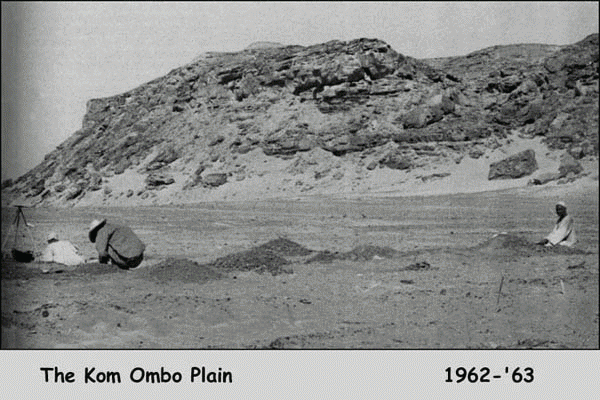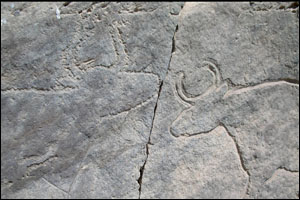Near current New Qurta, at the
northeastern edge of the Kom Ombo Plain, a Paleolithic site was
excavated in the 1960's, just before the area was developed for
agriculture:
|
|
On
the sandstone cliffs overlooking this site a large number of
petroglyphs, depicting bovids and other animals, were preserved despite
millennia of quarrying:
|
|
|
|
|

|
|

|
|
|
|
|
|
|
|
|
Objective of visit:
|
|
To survey the current
surroundings of the ancient petroglyphs near New Qurta. |
|
Date of visit:
|
|
February 2007 |
|
Fellow visitors:
|
|
A small team of archaeological
artists directed by Dr. Dirk Huyge of the Royal Museums of Art and
History in
Brussels (Belgium), funded by the Egyptology Endowment
Fund of Yale University (USA) and
Vodafone Egypt. |
| Results: |
|
A GPS-map of the area,
complemented by satellite images and calculated elevations, to
complement the detailed records of the ancient petroglyphs. Click here and here for
additional information (both in French). |
| Approximate
position
and date of the site: |
|
The Paleolithic site at New Qurta
was located on the north-eastern edge of the Kom Ombo plain, which in
ancient times received a regular supply of water from the Nile and the
seasonal rainfall in the desert. Excavations in the 1960's unearthed
stone tools and the bones of butchered wild bovids and hippopotami that
were dated to around 15.000 years ago. The nearby petroglyphs depicting
the same fauna were noted, but only cursory studied. More information
can be found in Ph.E.L. Smith (1976), 'Stone-Age
Man on the Nile,' Scientific
American 235: pp. 30-38, which is the source of black-and-white
photograph above. Since the 1960's the area has
been developed to house the Nubians, displaced after the closing of the
High Dam at Aswan, by spreading the Pleistocene silt layers on the
desert surface. The petroglyphs on the almost vertical cliff face
may now be the only remains of the Paleolithic inhabitants of the
region and were the focus of the research
project of Yale University and the Royal Museums of Art and
History. |
| Short
description of the site: |
|
In the south of Egypt, just north
of Aswan, a fault and the subsequent depression of the Cretaceous
Nubian sandstone formation forms a large low laying area, known as the
Kom Ombo Plain. The Nile deposited large amounts of silt on this plain,
much of which has recently been used to develop the area for
agriculture. In ancient time the region received more water, allowing
human settlement during the Paleolithic. These early inhabitants used
the vertical cliffs at the edge of the plain to depict, for reasons
only known to them, some of the animals (bovids, hippopotami, gazelles,
fish) that were an important part of their diet. Despite numerous human
alterations to the landscape, some of these petroglyphs have been
preserved until today. |
| Additional
remarks: |
|
My participation in this project
would not have been possible without the support of the Fayum Project, the Cotsen Institute of Archaeology
and many individuals. |
| HOME |
|
|
 |
|
|

